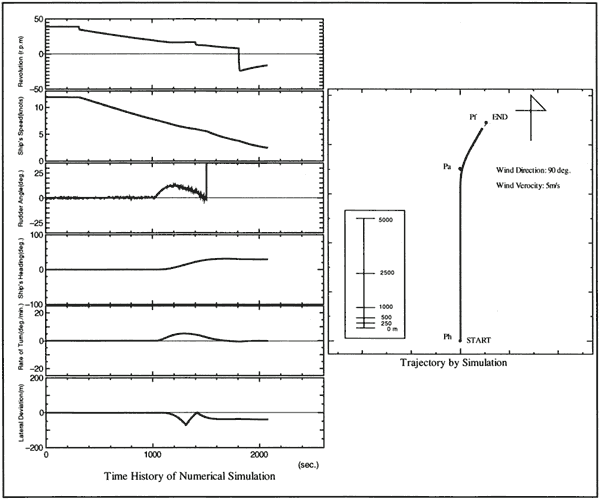|
3.4 The example of fairway design
In this section, we discuss the example of fairway design. The initial given elements are initial course and final position of ship handling Fig. 5 show the condition of fairway. The point of this case is setting of altering course point.
Fig.5 The dimension of fairway factor
a. Initial given data of fairway design
■The estimate position of ship-handling starting point: On initial course line
■Initial course: 0 degrees
■The finished position of ship-handling: The horizontal distance is 1000m from initial course
■Bending angle of alter course point: 30degrees
■The final speed: 3knots
■Designed External Force: Wind direction 090 degrees. Velocity 5m/s
Table 4 Calculation result of fairway factor
| Distance |
Starting point of ship-handling to starting point of course change operation: lS |
5985 m |
| Starting point of course change operation to altering course
point: 11 |
472 m |
| Altering course point to setting course point: l2 |
320 m |
| Setting course point to finishing point of ship-handling:
lf |
1684 m |
| Ship's speed |
Starting point of ship-handling |
12.0 knots |
| Starting point of course change operation: VS |
7.0 knots |
| Lateral deviation |
35m |
|
b. The factors of design
■Correct Position of starting ship-handling
■Ships speed at starting position of course change operation
■Position of altering course point
■Approach angle to finishing position of ship-handling
c. The consideration items to decide factor for design and result
The fairway factor is calculated by using the fairway design data which made the ship's maneuverability which should represent a Fig.4. A result of a calculation is shown in the Table 4 and the Fig.5.
A result of a simulation is shown in the Fig. 6. It is possible that a ship-handler passing the fairway which is planned based on the ship's maneuverability as shown.
Fig.6 The result of numerical simulation by human operator's control model
(Enlarged Image:36KB) |
 |
4. THE NUMERICAL SIMULATION BY HUMAN OPERATOR'S CONTROL MODEL
The ship-handler is whether to be possible to pass the fairway. The numerical simulation by human operator's control model was carried out and verified for fairway which is planned by the elements of fairway design. The human operators control model is used boosting operation and main engine control for simulated the actual ship-handling by human operator. And, other calculation conditions were same as numerical simulation by ship's maneuverability.
5. CONCLUSION
The summary from this research regarding fairway design by numerical simulation is as follows:
a. It is possible for the basic fairway design that it is designed based on the elements of fairway design.
b. It is possible that fairway design is held based on the ship maneuvering characteristics.
c. The fairway should be designed in consideration of not only the ship maneuvering characteristics but also the ship-handlers characteristics.
REFERENCES
[1] H.KOBAYASHI and S. SENDA, (2000). On the Standard Deceleration of Ship Speed by Human Control. MARSIM 2000 Conference Proceedings. pp439 - 438
[2] H.KOBAYASHI and S.SENDA, (2000). Human Factor on Ship-Handling in Restricted Waters. MARTECH 2000 Conference Proceedings
AUTHORS BIOGRAPHY
Captain Hiroyuki Mizuno is an Assistant General Manager of M.O. Marin Consulting, Ltd.
In 1984, he received a Bachelor of Merchant Marine degree from Kobe University of Mercantile Marine. He entered in Mitsui O.S.K. Lines as mate. He embarked LNG Carrier, Oil Tanker. Bulk Carrier, Container Carrier, Cable Ship and Semi container Carrier. He was appointed to Captain from Mitsui O.S.K. Lines in 2000.
He worked at an airship operation company as a pilot 3 years from 1989. His final job was an airship captain and an inspection pilot.
He was engaged in the education and the environment evaluation by ship maneuvering simulator in the present company for 4 years from 1995. He returned to the said company again at 2001 and present post.
|